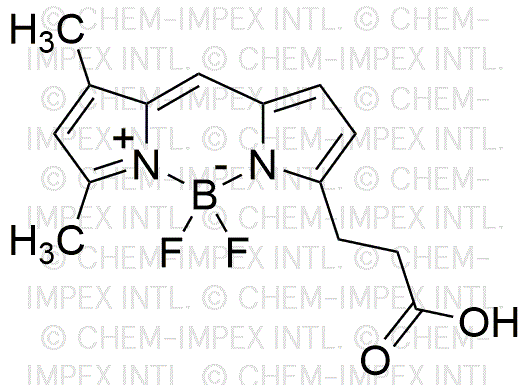4,4-Difluoro-5,7-dimethyl-4-bora-3a,4a-diaza-s-indacene-3-propionic acid is widely utilized in research focused on:
- Fluorescent Probes: This compound serves as a highly effective fluorescent probe in biological imaging, allowing researchers to visualize cellular processes with high sensitivity and specificity.
- Drug Development: Its unique properties make it valuable in the pharmaceutical industry for developing new drugs, particularly in targeting specific biological pathways.
- Photodynamic Therapy: The compound is used in photodynamic therapy for cancer treatment, where it helps to selectively destroy cancer cells upon light activation.
- Environmental Monitoring: It can be applied in environmental science to detect pollutants, providing a reliable method for monitoring water quality and other environmental parameters.
- Material Science: In material science, this chemical is used to create advanced materials with tailored optical properties, enhancing the performance of devices like sensors and light-emitting diodes.
Información general
Propiedades
Seguridad y normativas
Aplicaciones
4,4-Difluoro-5,7-dimethyl-4-bora-3a,4a-diaza-s-indacene-3-propionic acid is widely utilized in research focused on:
- Fluorescent Probes: This compound serves as a highly effective fluorescent probe in biological imaging, allowing researchers to visualize cellular processes with high sensitivity and specificity.
- Drug Development: Its unique properties make it valuable in the pharmaceutical industry for developing new drugs, particularly in targeting specific biological pathways.
- Photodynamic Therapy: The compound is used in photodynamic therapy for cancer treatment, where it helps to selectively destroy cancer cells upon light activation.
- Environmental Monitoring: It can be applied in environmental science to detect pollutants, providing a reliable method for monitoring water quality and other environmental parameters.
- Material Science: In material science, this chemical is used to create advanced materials with tailored optical properties, enhancing the performance of devices like sensors and light-emitting diodes.
Documentos
Hojas de datos de seguridad (HDS)
La SDS proporciona información de seguridad completa sobre la manipulación, el almacenamiento y la eliminación del producto.
Especificación del producto (PS)
La PS proporciona un desglose completo de las propiedades del producto, incluida la composición química, el estado físico, la pureza y los requisitos de almacenamiento. También detalla los rangos de calidad aceptables y las aplicaciones previstas del producto.
Certificados de análisis (COA)
Busque certificados de análisis (COA) ingresando el número de lote del producto. Los números de lote y de partida se pueden encontrar en la etiqueta de un producto después de las palabras "Lote" o "Lote".
Número de catálogo
Número de lote/lote
Certificados de origen (COO)
Este certificado de origen confirma el país en el que se fabricó el producto y también detalla los materiales y componentes utilizados en él y si se deriva de fuentes naturales, sintéticas u otras fuentes específicas. Este certificado puede ser necesario para cumplir con las normativas aduaneras, comerciales y regulatorias.
Número de catálogo
Número de lote/lote
Hojas de datos de seguridad (HDS)
La SDS proporciona información de seguridad completa sobre la manipulación, el almacenamiento y la eliminación del producto.
DownloadEspecificación del producto (PS)
La PS proporciona un desglose completo de las propiedades del producto, incluida la composición química, el estado físico, la pureza y los requisitos de almacenamiento. También detalla los rangos de calidad aceptables y las aplicaciones previstas del producto.
DownloadCertificados de análisis (COA)
Busque certificados de análisis (COA) ingresando el número de lote del producto. Los números de lote y de partida se pueden encontrar en la etiqueta de un producto después de las palabras "Lote" o "Lote".
Número de catálogo
Número de lote/lote
Certificados de origen (COO)
Este certificado de origen confirma el país en el que se fabricó el producto y también detalla los materiales y componentes utilizados en él y si se deriva de fuentes naturales, sintéticas u otras fuentes específicas. Este certificado puede ser necesario para cumplir con las normativas aduaneras, comerciales y regulatorias.


